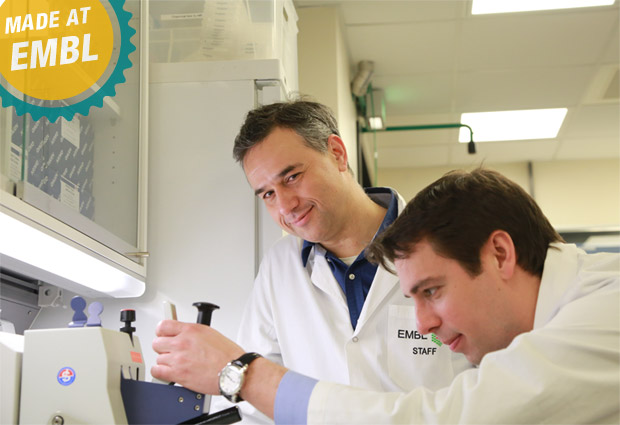
How to make a protein happy
Over the years, the scientists at the Sample Preparation and Characterisation Facility (SPC) at EMBL Hamburg have acquired untold expertise helping users to get the best results by optimising protein samples for structural biology experiments. Today, two new tools they developed to determine the ideal conditions for protein stability, purification and storage, are commercially available. Stephane Boivin, a staff scientist who initiated the project, tells us more about the RUBIC Buffer and Additive Screens, and the journey from idea to commercial product.

What can you do with the RUBIC screens?
It’s not easy to find the best working conditions for a protein. Information such as how a protein will respond to a certain buffer and what pH it prefers is very important, but identifying these parameters is often a laborious and frustrating process of trial and error. The RUBIC screens help scientists to systematically identify the conditions needed to keep their protein stable and happy – they are compatible with a wide range of proteins, so one size fits all!
How do they work?
The RUBIC Buffer Screen is designed to screen for general parameters that will keep proteins stable, while the RUBIC Additive Screen helps users identify ideal conditions specifically for protein purification and storage. The screens can be used alone, or in a two-step approach. The Buffer Screen contains diverse and varying solutions commonly used in structural biology experiments including differing salt concentrations, pH and buffer type. We use a fluorescence-based thermal denaturation assay (or Thermofluor) – as the protein unfolds with increasing temperature, the core of the protein becomes exposed so that a fluorescent dye can bind to it, increasing the visible signal. This means users can see when their protein starts to fall apart and so identify the optimal conditions in terms of pH, salt concentration and so on. Once the general parameters suitable for the protein have been determined, the Additive Screen can be used to pinpoint the ideal conditions for purification and storage.
Tell us about the journey from idea to commercialisation…
Over the years I have gained a lot of expertise using Thermofluor as a technique in the lab, and adapting it to specific projects and needs. As a postdoc at the University of Texas Health Science Center in Houston, I used Thermofluor to screen for buffer conditions to overcome antibody instability; I quickly realised it offers an effective way to explore stabilising conditions without using too much precious protein, providing some invaluable insights while saving a lot of frustration and time. I continued to use Thermofluor while at EMBL Grenoble, and when I moved to the SPC Facility at EMBL Hamburg we introduced it as one of a series of steps to help optimise experiments. In order to answer specific questions for in-house users we developed two screens that have now been tested on more than 300 different proteins – so we can safely say they are applicable in a wide range of cases! After publishing a paper, external users started requesting the screen, and so we began to distribute it as a prefilled, ready-to-use plate across EMBL and to other institutes. Biotech company Molecular Dimensions soon enquired about marketing the screen on a global scale.
What was it like to bridge the gap between research and commerce?
Thankfully EMBLEM, EMBL’s partner for technology transfer, took care of all the legal and contractual issues. That is not something we could – or should – do! Having said that, we were in regular contact with Molecular Dimensions as they started to produce the screen, and while we tested and validated it before large-scale production. We shared the protocols and information about how to set it up, how to interpret the results, how to trouble shoot, and we answered any open questions. As a result, the accompanying documentation contains easy-to-follow instructions and explanation. All in all, it has been a very interesting process and it is very satisfying to know the screen is now available to help many more users with their research.


